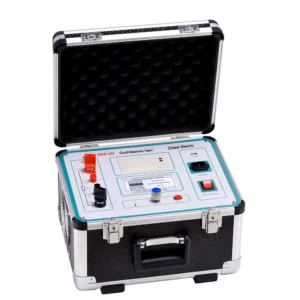A contact resistance tester, also known as a micro-ohmmeter or low-resistance ohmmeter, is primarily designed for measuring the electrical resistance of conductive materials, such as electrical connections, joints, or contacts. It is not typically used to handle oil samples or analyze the composition of fluids, including those with high levels of oxidation by-products.
However, if the presence of oxidation by-products in an oil sample is suspected to affect the electrical conductivity or resistance of conductive materials being tested, it may indirectly influence the measurements obtained with a contact resistance tester.
Here’s how a contact resistance tester might handle such scenarios:
- Impact on Conductive Surfaces: High levels of oxidation by-products in oil samples may cause corrosion, oxidation, or surface contamination on conductive surfaces, such as electrical contacts or connections. These surface irregularities can increase contact resistance and affect the accuracy of resistance measurements obtained with a contact resistance tester.
- Cleaning and Preparation: Before performing contact resistance measurements, it’s essential to ensure that the conductive surfaces are clean, free of contamination, and properly prepared to establish good electrical contact. Cleaning methods, such as solvent cleaning, abrasive cleaning, or mechanical brushing, may be used to remove oxidation by-products and restore surface conductivity.
- Measurement Technique: When using a contact resistance tester, it’s crucial to establish stable and consistent contact between the test probes or electrodes and the conductive surfaces being tested. contact resistance tester Proper probe placement, pressure application, and contact area optimization are essential to minimize contact resistance and obtain accurate resistance measurements.
- Interpretation of Results: In situations where oxidation by-products are suspected to influence resistance measurements, it’s important to interpret the results cautiously and consider potential sources of measurement error. Anomalies or deviations in resistance readings may indicate underlying issues related to surface contamination, corrosion, or degradation of conductive materials.
- Validation and Verification: To ensure the reliability and accuracy of resistance measurements, it’s recommended to validate and verify the measurement setup, calibration, and testing procedures. Performing periodic calibration checks, using reference standards, and comparing results against established criteria can help identify and correct measurement errors associated with oxidation by-products or other factors.
Overall, while a contact resistance tester is not specifically designed to handle oil samples or analyze oxidation by-products, it may indirectly detect changes in contact resistance caused by surface contamination or degradation resulting from oil contamination. Proper cleaning, preparation, measurement techniques, and result interpretation are essential to mitigate the influence of oxidation by-products on contact resistance measurements and ensure accurate testing of conductive materials.
